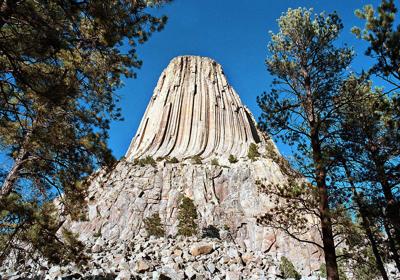CHEYENNE, Wyo. An effort is underway to change the name of Devils Tower National Monument, a giant rock butte in northeast Wyoming.
Local American Indians and others say the name is inappropriate given the towers religious significance. Theyre seeking to have it switched to Bear Lodge.
Here are some key things to know about the geological feature:
First U.S. monument
President Theodore Roosevelt designated Devils Tower the countrys first national monument on Sept. 24, 1906, under new authority granted to him in the Antiquities Act. Congress passed the measure to help protect unique U.S. sites.
How did it form?
The most accepted theory is that Devils Tower was created by underground magma that cooled and hardened into igneous rock.
The magma shrank and cracked, forming multisided columns. Weather and the nearby Belle Fourche River then eroded the softer rock surrounding the hard columns, exposing the tower over time. The columns make the tower a popular place for rock climbers.
Piles of rubble, boulders and stones at the towers base likely are column pieces that have broken off over the years.
Native Americans and
the Tower
About two dozen area tribes have maintained some affiliation with the tower over the centuries.
Tribes have their own stories passed down through generations about how the jagged butte formed. The most popular ones attribute it to a large bear clawing at a mountain where people had taken refuge to escape it.
Various tribal languages have names for the tower that translate in English to: Bears House, Bear Peak, Bear Lodge, Tree Rock, Gray Horn Butte and Grizzly Bears Lodge.
Devils in the details
According to the National Park Service, most maps from 1874 to 1901 mark the feature as Bears Lodge.
The name change happened during this period with information brought back by an expedition led by Col. Richard Irving Dodge.
The group sent a small contingent, including a geologist and mapmaker, to study the tower. When they returned, they reported the Indians call this place bad gods tower, a name adopted with proper modification.
And so, the label Devils Tower was born.
No other records indicate Native Americans associated the tower with any kind of evil spirit.
Movie fame
Devils Tower was the focus of the movie Close Encounters of the Third Kind, which depicted an alien encounter. The movie, directed by Steven Spielberg, was released in 1977.
Since then, the site has been a draw for fans of the film and people interested in UFOs.
Name changer
Proponents of the name change have petitioned the U.S. Board on Geographic Names, which approves and standardizes geographic labels for the federal government.
The panel receives hundreds of proposals each year to name or rename features ranging from mountains to streams. Here are a few other requests pending before it:
Naming an 80-foot summit in Colorados Rocky Mountain National Park Hazels Cone in honor of a woman who operated cottages near a park entrance.
Changing the name of Gary Ditch in Brunswick, Ohio, to Goodyear Creek. The proponent says ditch connotes degradation and is not a pleasant word for a stream.
Giving the name Tubsinte Hill to a 135-foot summit on San Francisco Bays west side. The name recognizes a Yelamu Ohlone village that existed in Visitacion Valley in the mid- to late 18th century.


